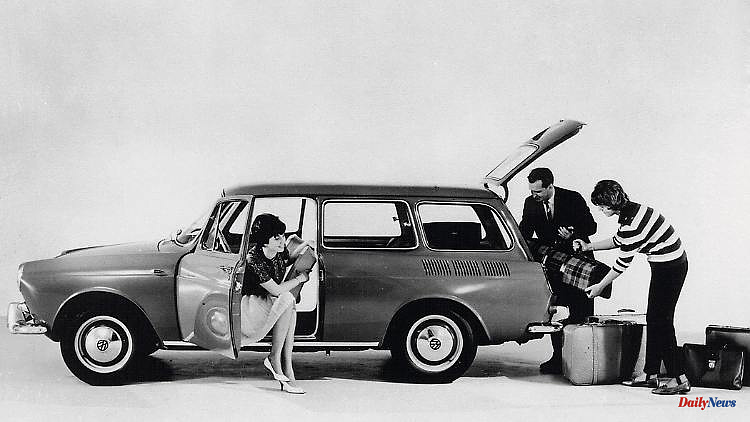As is so often the case, the Wolfsburg company came late with a model, but was then all the more successful than others. And so the VW Type 3 Variant in 1962 made even the full-size spoiled Americans want small family station wagons. In the end, however, that was only the beginning of a hype that encompassed almost all VW models from the Polo to the Passat.
Family, vacation, station wagon, in the summer of 1962 the hype about huge US station wagons in North America reached a new high. Even in the Europe of the economic miracle, station wagons have long been indispensable as loadmasters for trade and crafts, but utility as a chic family car? Proven freighters such as the Ford Tournament or Opel Caravan rarely lived up to this claim, and the German station wagons only became popular as a vehicle for joie de vivre and leisure culture with the Volkswagen 1500 Variant (Type 3) presented in 1962.
Ironically, this conservative rear-engine type, designed for Beetle climbers, set a historic milestone as the first European mid-size class that was bought by half of the customers with a practical station wagon rear. This was the beginning of the 60-year success story of the Variant models, which produced family and leisure models of all sizes: the middle-class Boxer VW 1500/1600 and 411/412 were followed by bestsellers such as the Passat and Golf, which are still in demand today. But also small, short-lived specialties à la Polo and Bora Variant, hot chili with GTI and R sports badges, crossover fare known as all-terrain, exquisite haute cuisine with a W8 engine and Connolly leather in the Passat, through to plug-in Pioneers and extravagant Arteon Shootingbrakes. Wolfsburg often dared more station wagons than the competition, even risked flops, but perhaps this is exactly the reason why the Variant idea was able to survive into the SUV age.
An idea whose origins can be found in the United States. There it was the overwhelming success of the VW Bulli T1, advertised as a station wagon, that encouraged Werner Jansen, head of VW Canada, in 1960 to inquire about a classic station wagon in Wolfsburg, namely as a stylish multi-purpose vehicle based on the two-door "Squareback" Sedan type 3. The Bulli T1 had already achieved cult status in North America because, despite its compact dimensions, it held more luggage than the unwieldy, long chrome cruisers from Detroit. In addition, the Lower Saxon tin dress remained fresh for years, while the fashion passed over the US models in quick steps. Value-preserving model consistency therefore also determined the long life cycle of the VW 1500/1600 Variant, which only found a successor in 1974 in the first Passat. By then, the Type 3 Variant with its two trunks (front and rear) had sold more than 1.2 million buyers (an announcement at the time), and it had spread the Variant idea across the globe.
Not only the North Americans liked the constructive relationship of the Tailgate Type 3 to the long-serving but reliable Beetle. After all, the station wagon was able to enhance the familiar VW technology in the mid-1960s with high-tech features: "A car with a computer in it". This US advertising slogan matched the space race that was going on at the time, in which the USA was ahead by a nose - even if the "computer" in the VW 1600 consisted only of a new type of electronic fuel injection. Such technical refinements were not in demand in South America. There, the independently designed VW 1600 Variant or Variant II stirred up the station wagon market until 1980, when a test run of today's cooperation between VW and Ford was initiated: The Passat Variant, which was newly introduced at the time, was produced in Brazil at the same time as the Ford Royale.
With increasing prosperity, the demands of car buyers grew in Europe and the USA at the end of the 1960s. Suddenly the Type 3 Variant was left behind by new, more powerful and more modern competitors. Reason enough for Wolfsburg to follow suit in 1969, this time with the flagship VW 411 Variant, with a self-supporting body, more luggage space and more comfort, as Americans also appreciated, but still with the rear engine layout. The future for these vehicles from Beetle's legacy did not look too bright. The largest air-cooled model, which was upgraded to the 412 in 1972, achieved only one triumph: It sold better than the first front-wheel drive VW of the K70 type.
And then it came, the Passat. Named after the tropical winds so prized by sailors, this Volkswagen set the whole of Wolfsburg on a fresh course in 1973/74. "Passat. Something new begins with this car," was the title of the introductory campaign for the mid-range model, which, with modern technology and the first five-door variant, marked the end of the car giant's rear-engine era. In fact, the Passat found its way out of the crisis into which the VW group fell after the Beetle
While the compact Golf was always very European in concept, the larger Passat was a global quick-change artist that fulfilled almost all special regional requests. There was the Passat Variant under the Audi Fox label for the USA and right-hand drive markets, as the Corsar for Mexico or the Carat for Argentina, or simply the VW Variant in China. Back to the home market. A facelift with plastic bumpers was enough for the first Passat generation to stay fresh and ahead of the field in the station wagon segment until the 1980 model change. The significantly larger Passat Variant B2 presented itself in 1981 with technical surprises. The bundle of innovations included all-wheel drive, turbodiesel, five-cylinder petrol engines and fuel-saving Formula E technology, which, however, was too far ahead of its time.
Even bold design is not always rewarded. The Passat Variant experienced this when the third edition (1987 to 1993) did without a classic radiator grille. The shape, mocked as a jacket potato design, was therefore revised by the fourth Passat generation (1993 to 1997). At the same time, the station wagons were positioned higher with premium attributes. Initially, these were compact six-cylinder, powerful TDI diesel, but in the fifth generation (1996 to 2005) there was also an expensive eight-cylinder machine. The Passat Variant as a small Audi A8 Avant, the customers didn't want to accept that after all. On the other hand, Volkswagen was particularly successful with the Alltrack in an off-road look, which was introduced as a derivative of the seventh Passat generation (from 2009) and established itself as a crossover alternative.
To this day, the eighth Passat Variant has succeeded in continuing the success story of the series as evenly and consistently as the trade winds blow across the seas. A plug-in hybrid may be, with the latest Golf Variant there is also a natural gas version and a furious Golf R 4Motion to choose from, but otherwise the VW Variants do without experiments. After all, the Wolfsburg station wagons have survived most of their competitors who have given way to the SUV hype. Incidentally, prototypes of a future Passat Variant B9 have already been spotted, which is the best news for station wagon fans on the occasion of the Volkswagen Variant anniversary.












